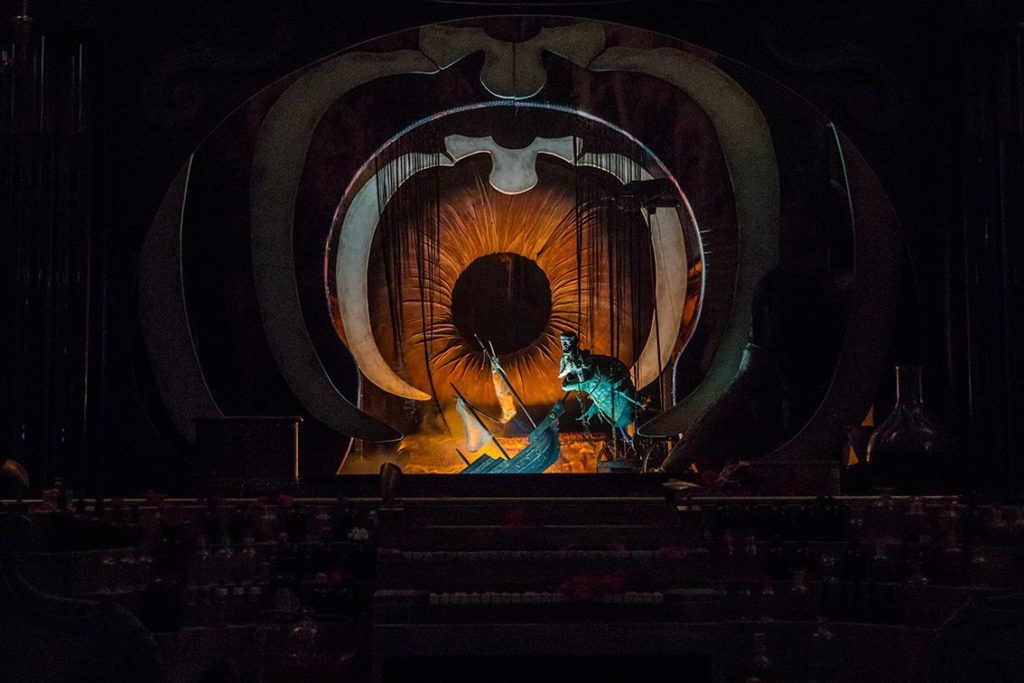Words by Bengi-Sue Sirin.
There is always many a treat to be found at London’s fantastic annual mime festival, MimeLondon. So en route to the Barbican, into its darkest depths of the Pit Theatre, I expected to encounter something unusual. But quite how unusual I was not able to predict!
The French puppet theatre company, Les Antliaclastes, have been dazzling audiences for several years now, and their latest piece Ambergris is no exception. The show is named for the ‘intestinal slurry’ (National Geographic’s words, not mine) ejected by sperm whales that hardens into a waxy, musky mass, the scent of which has so allured perfumiers that it has been an extremely valuable commodity for centuries. Yup, whale slurry. Ambergris describes itself as ‘a strikingly visual retelling of the story of Pinocchio set inside the belly of a whale.’ And with a healthy dose of Moby Dick and Jonah thrown in too, the whale lore is complete. It’s literary, creative and bizarre – right up my street.
As the lights go down, the set immediately transports us to the realm of fantasy. It is a sort of hybrid beast, fusing ship deck with Wurlitzer organ with perfume laboratory with belly of a whale. Nothing is static – mermaids pop out of cuckoo clock doors; a train track whizzes containers of liquid round and round; and perfume bottles light up, popping flowers out of their necks like the dresses of Schiaparelli… Lighting is cleverly utilised, taking the form of the flashes of the fairground just as readily as the searchlight of a ship. Les Antliaclastes are masters of utility and this set is like a giant, awesome apothecary box. You don’t know what they’ll pull out of it next!

And out from unexpected corners of this Narnia cupboard spring our peculiar cast. Pinocchio trundles along the train tracks in a sorry state, looking rather corpse-like in a wagon that could be a coffin. He has the donkey ears that in Carlo Collodi’s story signify his time gambling and being a general rapscallion in the Land of Toys. Ahab surfaces grimly after a warning sound of echoing footsteps, all beard and shadow. We see Jiminy Cricket, cutting a rather Gregor Samsa-esque figure. An unexpectedly coy puppet whale lollop-glides itself to sit on a toilet, in anticipation of a colon-bursting excrement that – we hope – will transform into ambergris. And my favourite; a Gogol-sized perfumier Nose, dressed for Louis XIV’s court all frill and wig. All are odd, all are funny, and all catch you by surprise.
I have devoted several words to descriptions of characters and set, purely because there are so many fascinating elements to them that it feels a disservice to leave any out. But that is not to say that Ambergris lacks narrative. There is a story there, with a beginning and middle and an end. Two journeys are chronicled: Pinocchio and Ahab’s journey to the belly of the whale, and the ambergris of said whale’s journey to the laboratory of the nose-perfumier. I must say that I needed some gaps filled by my companion, as I was preoccupied with the wonderment of the whole thing. That didn’t matter to me! Ambergris was a truly joyful journey of my own, which reminded me how both delightful and admirable craft and creativity are.
In the live action Pinocchio the Blue Fairy tells him, “To be real is up to you.” With Les Antliaclastes I feel a slight variation on this theme. Instead: to be surreal is up to you. I found it remarkable how the worldbuilding of Ambergris is so potent that it takes no time at all to accept the surreal as real.
